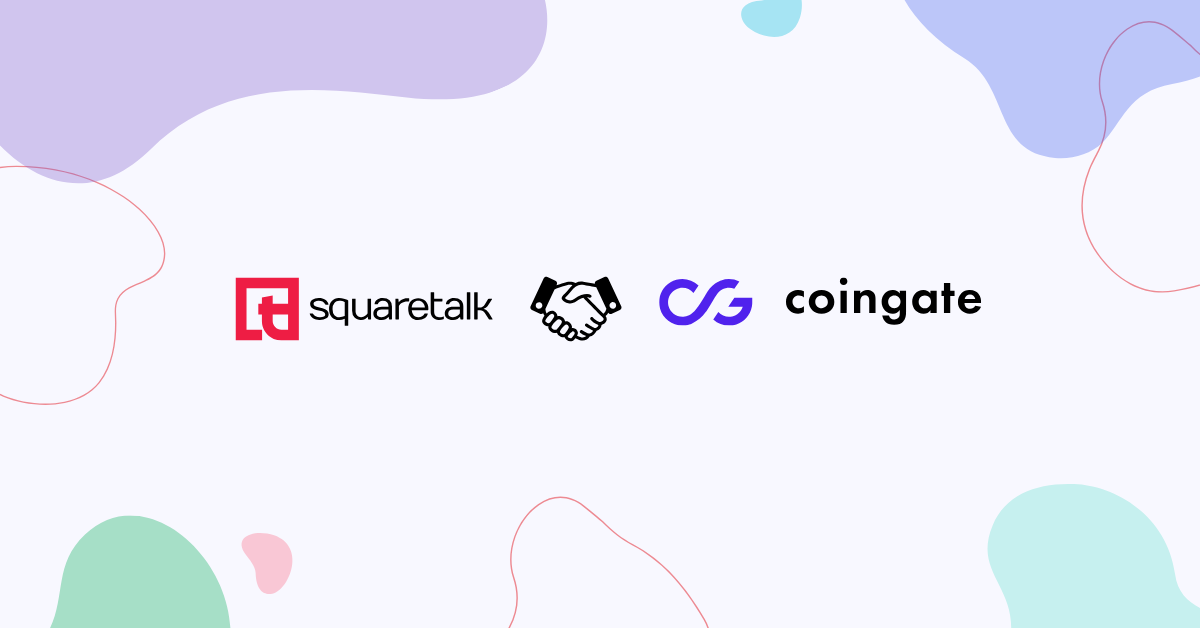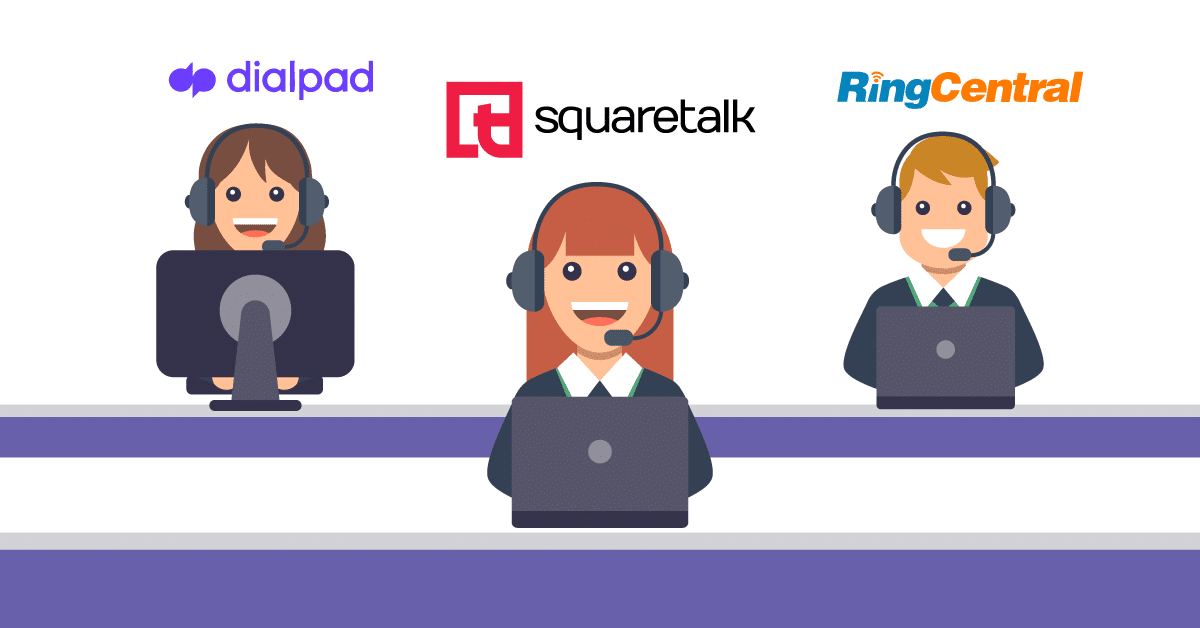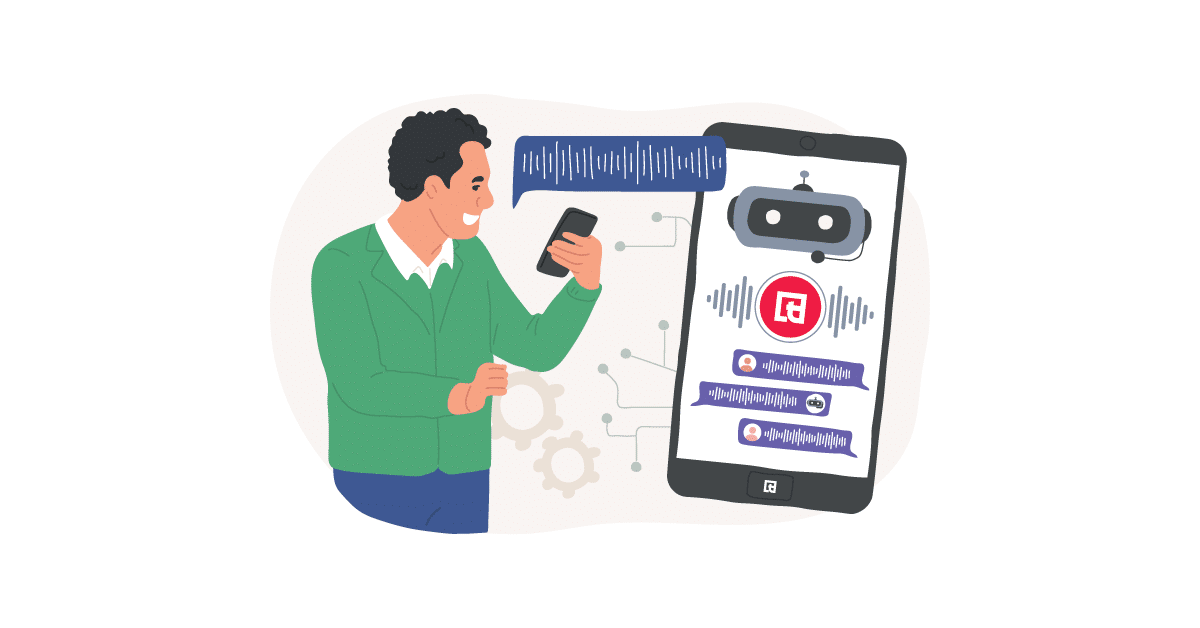Imagine this: a caller has been waiting on the line for a while and is finally connected to a free agent. This moment is critical – it can either salvage the customer’s experience or push them towards a 1-star review.
But which one is it? And how can your business measure the success and impact of this interaction?
Here is where CSAT – Customer Satisfaction Score – comes into play. It offers you immediate feedback on whether the lengthy wait was offset by exceptional service or if it instead added to the caller’s aggravation.
But what exactly is CSAT and why is it so crucial in the call center industry?
This comprehensive guide explores its definition, significance and impact on both the customer perception of your brand and the business performance.
What is CSAT?
At its core, CSAT measures the degree to which a customer is satisfied with a specific interaction, product or service.
Customer satisfaction benchmarks vary depending on your industry, product, service and customer base. However, as a general rule, anything above 75% is considered a good score, while those below 50% indicate you need to reevaluate and improve your service.
Getting a near-perfect score is very difficult. CSAT at 75% means that three out of every four customers gave you a positive score instead of a negative or neutral one.
CSAT Surveys
Customers are usually asked to give their feedback with brief questionaries. There do it by using a scale, from 1 to 5 for example, or by choosing from provided options (like “Yes” or “No”).
In the numerical ratings, 1 typically represent the lowest level of approval (“Very Unsatisfied”) and 5 the highest (“Very Satisfied”). This type of scale is great for quick, short and general surveys or an audience that may not be as engaged. Fewer options are also less overwhelming, making it easier for people to provide accurate answers.
A 1-to-10 scale, on the other hand, captures subtle differences and precise distinctions in satisfaction levels. It’s ideal for more engaged respondents or longer surveys where you need detailed feedback. The argument for more options here is that it can encourage respondents to think deeper about their level of satisfaction and provide more precise answers.
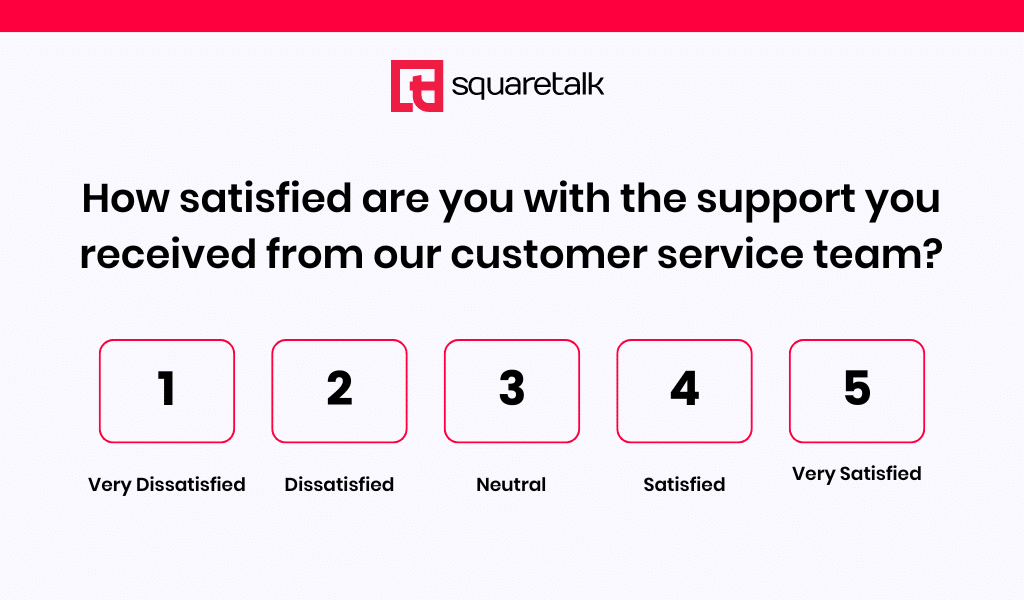
CSAT survey questions usually look like this:
- “On a scale of 1 to 5, how happy are you with the service you received today?”
- “How well were your concerns addressed?” (Very poorly / Poorly / Adequately / Well / Very well)
- “Was your issue resolved fast enough in your opinion?” (Yes / No)
The questions are intentionally simple to allow for quick responses and high participation rates. This ensures you can gather as much valuable data as possible to assess and improve your service quality.
What are The Pros and Cons of Tracking CSAT?
While customer satisfaction score is a widely used metric in call centers, it’s important to understand both its advantages and limitations.
Pros of Measuring CSAT
- 1. Direct Customer Feedback: CSAT provides immediate and straightforward input about customer experiences. This is invaluable for understanding client perception of your brand and service quality.
- 2. Quantifiable Metric: CSAT offers a numerical measure of customer satisfaction, making it easier to track progress over time and set concrete goals for improvement.
- 3. Identifiable Areas for Improvement: By analyzing CSAT scores across different aspects of service, you can pinpoint specific things to work on.
- 4. Increased Employee Morale: Good CSAT scores can serve as positive reinforcement for call center agents, potentially improving job satisfaction and performance.
- 5. Clear Comparison: CSAT scores allow companies to benchmark their performance against industry standards or competitors.
- 6. Customer-Centric Culture: Regularly measuring and discussing CSAT scores with employees at all levels reinforces the importance of customer satisfaction in every interaction and decision.
Cons of Measuring CSAT
- 1. Potential for Survey Fatigue: Frequent CSAT requests may lead to customer annoyance or disengagement, potentially skewing results or reducing response rates.
- 2. Limited Scope: CSAT typically measures satisfaction with a specific interaction, which may not capture the customer's overall experience with the company. Looking at CSAT without considering other important metrics will give you an incomplete and distorted picture.
- 3. Risk of Score Manipulation: There's a potential for agents to try to manipulate scores by explicitly asking for high ratings, which will lead to inaccurate data.
- 4. Influenced by Factors Beyond Your Control: CSAT scores can be affected by things that have nothig to do with the service quality, like product issues or unrealistic customer expectations.
- 5. May Not Predict Customer Behavior Accurately: High CSAT scores don't always correlate with customer loyalty or repeat business, as other factors influence these outcomes as well.
- 6. Cultural Bias: CSAT scores can be imacted by cultural factors, making cross-cultural comparisons challenging.
Balancing the Pros and Cons
While it’s important to consider the potential downsides of tracking customer satisfaction score, they don’t negate its value as a metric. Instead, they highlight the need for a thoughtful and balanced approach. Only then can CSAT tracking contribute meaningfully to your overall optimization efforts.
How Important is CSAT in Call Centers?
CSAT’s significance extends far beyond a simple numerical score. It’s a powerful tool that impacts multiple aspects of your business if used as:
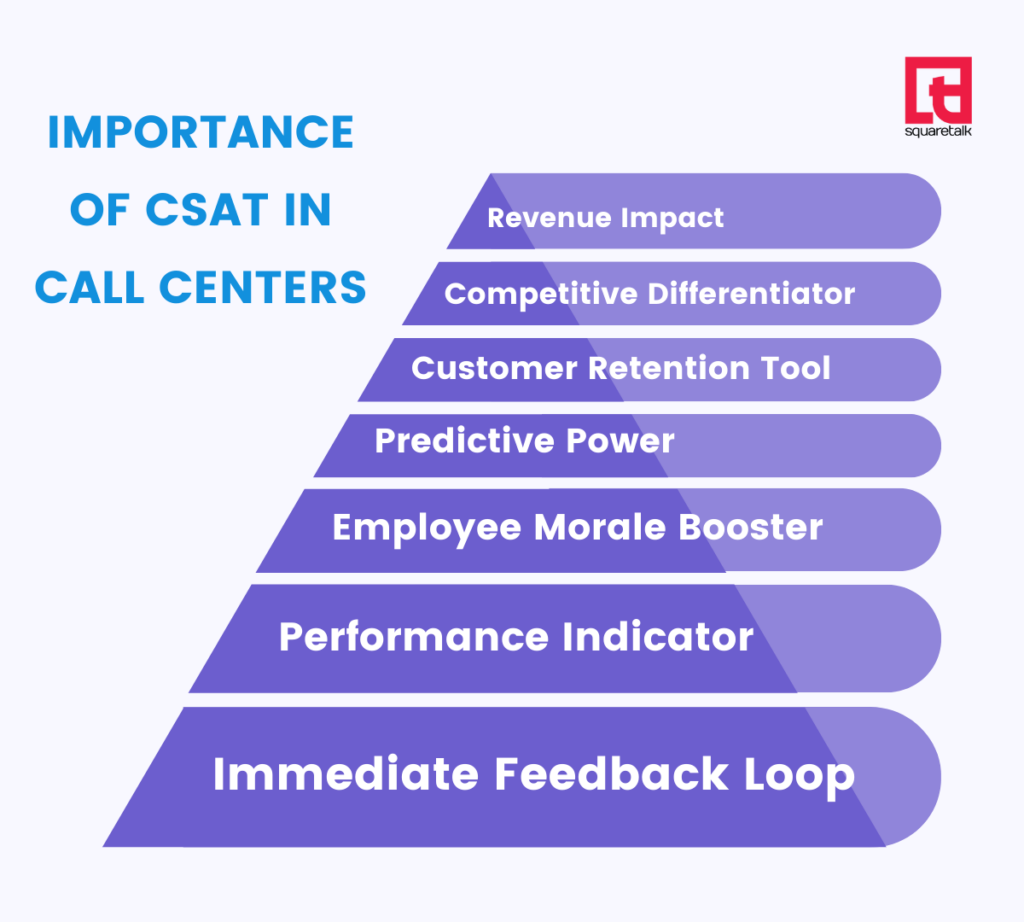
- Immediate Feedback Loop: CSAT provides real-time insights into customer experiences. When they rate an interaction poorly, you can immediate follow up and attempt to resolve the issue. For instance, a low CSAT score might prompt a supervisor to call the customer back, addressing any lingering concerns and potentially turning a negative experience into a positive one.
- Performance Indicator: For call center managers, CSAT serves as a crucial metric in evaluating both individual agent and overall team effectiveness. High scores often reflect efficient problem resolution, clear communication and empathetic customer service.
- Employee Morale Booster: CSAT also impacts the employee experience. When agents consistently receive positive feedback, it reinforces the value of their work, leading to increased job satisfaction. This is particularly important in call centers, where turnover rates are notoriously high.
- Predictive Power: CSAT scores can serve as early warning systems for larger issues. A sudden drop in customer satisfaction might indicate a problem with a new product, a flaw in a recent policy change or a gap in agent training. By catching these issues early through CSAT monitoring, you can address problems before they escalate.
- Customer Retention Tool: Studies have shown a direct link between customer satisfaction, loyalty and repeat business. A report by Bain & Company, for example, found that increasing customer retention rates in the financial industry by 5% can improve profits by 25%.
- Competitive Differentiator: In industries where products or services are very similar, high CSAT scores can set a company apart from its competitors. For example, Zappos, an American online shoe and clothing retailer known for its exceptional customer service, has built its entire brand around customer satisfaction, leading to remarkable client loyalty and business growth.
- Revenue Impact: CSAT directly affects your company's bottom line with more than higher retention rates. For call centers that handle high volumes of service interactions, even small improvements can result in significant income gains. A study by InfoQuest found that a totally satisfied customer contributes 2.6 times as much revenue as a somewhat satisfied and 17 times more than a somewhat dissatisfied one. At the same time, totally dissatisfied customers decrease 1.8 times the earnings a totally satisfied client contributes to your business.
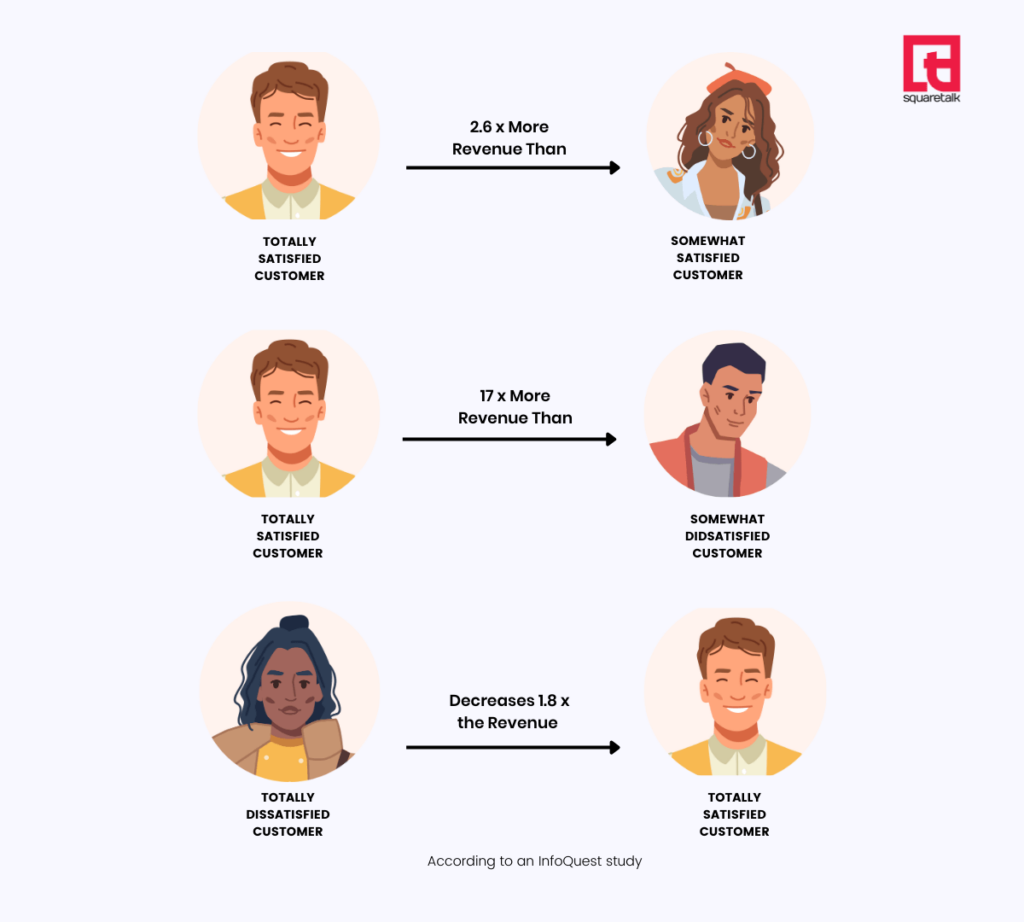
How to Collect CSAT Data in Call Centers?
Effective CSAT data gathering is crucial for gaining meaningful insights. Here are key factures you need to consider:
Timing
You should send surveys immediately after an interaction when the experience is fresh in the customer’s mind. This ensures the most accurate reflection of the encounter.
Some of the best moments to send a survey are:
- During Onboarding (to gather feedback on the initial experience, to ensure this process is smooth and effective and to identify issues early on)
- After a Purchase (to get insights into the buying process and the customer satisfaction with the product/service)
- After Delivery (to evaluate the distribution process and the condition of the product/service and see areas for logistical improvements)
- Bedore Contract/Service Renewal (to measure customer satisfaction and address any concerns ahead of them deciding whether or not to continue working with you)
- After Customer Support Interaction (to assess the service quality and the effectiveness of the provided resolution)
- After Call Escalation (to evaluate how efficient and effective your escalation procedures are)
- Post Self-Service (to identify areas for improvement and further reduce the need for live agent support)
Channels
Diversifying collection methods can increase response rates and provide a more comprehensive view of customer satisfaction. You can use:
- Post-Call IVR Surveys: At the end of a service call, the agent may ask the customer if they would be willing to participate in a brief survey. If the client agrees, they are transferred to the Interactive Voice Response (IVR) system. It then proceeds to ask pre-recorded questions and collect answers, typically using the phone's keypad (e.g., "Press 1 for Yes, 2 for No") or voice recognition. Responses are automatically recorded and stored in the system and can be analyzed in real- or near-real-time. You can configure the IVR to alert managers for critical issues or extremely negative feedback that need immediate follow-up.
- Email Surveys: Sent shortly after interactions, they offer a convenient and flexible way for customers to provide feedback at their own pace. From a business point of view, email surveys are relatively inexpensive to design and distribute to a large audience. With the option for more open-ended questions, they are ideal for collecting in-depth feedback and identifying common themes. It’s important to note that email surveys often have lower response rates compared to other review methods. Customers might also find longer questionaries time-consuming and abandon them halfway.
- SMS Surveys: Sent to customers via text message, they typically involve short, concise and limited-numbered questions that can be answered quickly through SMS responses. They are convenient for on-the-go customers and have significantly higher open and response rates than emails. SMS surveys can be personalized with the customer’s name and specific details about their interaction to make the review process more engaging. Due to the character limits, this feedback collection method offers less detailed questions and answers.
- Chat Surveys: At the end of a chat session, the customer is prompted by a live agent or automatically by a chatbot to take a quick survey on the digital interaction. The questions can be directly and conveniently embedded in the live chat or the client can be directed to a separate page with a link. Chat surveys engage customers in a conversational manner, which can feel more personal and informal.
- Web Intercept Surveys: They are pop-up or embedded surveys that appear during a website visitor’s browsing. This can be triggered by user behaviors, like time spent on a page, scroll depth and other specific actions, or delivered to a random sample of visitors. Web Interaction Surveys’ biggest benefit is gathering feedback in the context of the user’s current interaction, leading to more accurate and relevant responses. They are also very engaging and can target specific user segments for more tailored customer input.
Frequency
Regular feedback collection ensures up-to-date insights. However, it’s important to balance the need for information with the risk of survey fatigue. Too frequent feedback requests can be ignored or even have a negative effect on the customer’s opinion of the brand. This is why many call centers opt for surveying a random sample of clients rather than every interaction.
Consistency
Using the same rating scales, question wording and format over time and across different channels helps you compare and accurately track CSAT. This makes it easier to aggregate data and draw meaningful, reliable and valid insights.
Uniformity also simplifies the process for the customers – it reduces cognitive load and improves the overall experience for those who interact with multiple channels. The consistency also signals professionalism and reliability, helping to build trust with clients and make them believe that their feedback is valued and used effectively.
How to Measure CSAT?
Once you’ve collected CSAT data, the next crucial step is to measure and interpret it effectively.
1. Calculate the CSAT Score
The basic CSAT calculation is very straightforward:
- Count the number of satisfied customers (those who rated 4 or 5 on a 5-point scale, for example).
- Divide this by the total number of survey responses.
- Multiply by 100 to get a percentage.

For example:
If 75 out of 100 customers rated their satisfaction as 4 or 5, your CSAT score would be 75%. Good job!
CSAT Calculator
Another way to estimate your CSAT score is to put all of the responses into a calculator (this example is also based on a 1-to-5 scale):
2. Interprete CSAT Scores
While higher scores are generally better, interpreting CSAT, like most things, needs context:
Industry Benchmarks
Always compare your scores to your niche’s standards. After all, technical support demands inherently differ from the empathetic help needed in healthcare.
Besides varying norms and customer expectations, support call centers also have different impact on client satisfaction in each industry. For example, while retail and financial CSAT benchmarks are somewhat similar (80% and 79% respectively), they aren’t a result of the same factors. In E-commerce, high CSAT scores are typically influenced by the direct impact customer service has on immediate purchase decisions. On the other hand, call centers in financial services handle sensitive and complex issues and customer trust and satisfaction can be affected by the nature of inquiries and regulatory constraints.
Trends Over Time
It’s better to look at CSAT scores through longer periods. Analyzing them month-to-month or year-to-year helps you identify patterns or recurring issues that impact customer satisfaction. Certain industries also experience seasonal fluctuations. By monitoring monthly changes, you can account for and understand these variations. Also, when you implement new policies, processes or technologies, tracking CSAT scores over longer time helps better assess their impact.
Specific Contexts
Perspective gives you a better understanding of the impact of specific actions, like a significant improvement in CSAT scores following a campaign is most likely validation of its success or a score drop after a policy change signals the need for reassessment and potential modifications. Context also helps differentiate between a temporary dip due to a recent system upgrade, for example, and a more extensive issue that requires a strategic overhaul.
3. Segment CSAT Data
Segmentation can reveal specific areas for improvement and help in resource allocation. To gain deeper insights, you have to break down your CSAT scores:
- By Agent: Identify top performers and those who may need additional training.
- By Product/Service: Pinpoint which offerings are meeting (or failing) customer expectations.
- By Customer Demographics: Understand how satisfaction varies across different customer groups.
- By Time: Spot patterns in satisfaction levels at different times of day or days of the week.
4. Combine CSAT with Other Metrics
CSAT becomes even more powerful when combined with other key performance indicators (KPIs), like:
- Net Promoter Score (NPS): Measures customer loyalty and likelihood to recommend.
- Customer Effort Score (CES): Assesses how easy it was for the customer to get their issue resolved.
- Operational Metrics: Consider CSAT alongside KPIs like Average Handle Time (AHT) or First Call Resolution (FCR) for a more comprehensive view of performance.
By connecting CSAT with these metrics, you can identify which factors have the strongest influence on customer satisfaction.
How to Improve CSAT Scores in Call Centers?
Improving CSAT scores requires a multifaceted approach. Here are key strategies:
Act on the Insights
The ultimate goal of measuring CSAT is to drive improvements. For each analysis:
- Identify key findings: What stands out in the data?
- Determine root causes: Why are you seeing these results?
- Develop action plans: What specific steps can you take to improve?
- Set targets: What CSAT score do you aim to achieve and in what time frame?
- Regularly monitor progress: Are your actions actually moving the needle?
Enhance First Contact Resolution
FCR is strongly correlated with high CSAT scores. Customers appreciate having their issues resolved without the need for follow-ups, transfers or escalations.
- Empower agents with comprehensive knowledge bases and decision-making authority.
- Implement a robust Customer Relationship Management system (CRM) for a complete view of customer history.
- Develop problem-solving focused training programs.
Personalize Customer Interactions
Customers appreciate feeling valued and understood, which can significantly enhance the service experience.
- Use CRM data to tailor conversations to individual customer histories and preferences.
- Train agents to recognize and effectively respond to emotional cues.
- Consider implementing AI-powered systems that suggest personalized solutions based on customer data.
Reduce AHT Without Compromising Quality
While quick resolutions are appreciated by customer, it’s crucial to balance speed with excellent service.
- Optimize skill-based call routing to connect customers with the most suitable agent.
- Provide agents with quick access to relevant information by integrating your tools and systems.
Invest in Continuous Agent Training
Prepare your staff to handle diverse customer needs and complex situations.
- Conduct regular role-playing exercises to refine communication skills.
- Provide regular product and service training.
- Offer emotional intelligence lessons to improve customer interactions.
Implement a Robust QA Program
Regular evaluation and feedback can help you maintain high service levels.
- Develop clear quality standards and regularly evaluate calls according to them.
- Provide timely and constructive feedback to agents.
- Use speech analytics to identify trends and training opportunities.
Foster a Customer-Centric Culture
Creating an overall environment that prioritizes customer satisfaction can drive long-term improvements in CSAT scores.
- Ensure that your service quality is consistent across all customer interactions.
- Encourage all employees, not just customer-facing ones, to focus on delivering exceptional service.
How to Factor Cultural Differences in CSAT?
When measuring and improving CSAT in a global context, it’s crucial to recognize that customer satisfaction can be influenced by cultural factors. What constitutes excellent service in one culture may not be perceived the same way in another. CSAT scores for multinational companies can be misleading or incorrect if you don’t factor in cultural differences not just in the service approach but also in the way you construct your surveys.
Here are some key cultural considerations for CSAT in call centers:
Communication Style
Different cultures have varying preferences for communication. Norms around politeness, formality, personalization and communication styles differ significantly.
- Direct vs. Indirect Style
Some countries prefer straightforward communication, while others value a more nuanced approach.
In some Middle Eastern countries, for example, building a relationship is often seen as a prerequisite to problem-solving. An agent who jumps straight into resolving an issue without first engaging in pleasantries might be seen as abrupt or rude, potentially leading to lower satisfaction scores.
- Formal vs. Informal Communication
The etiquette expectations can vary significantly.
In many Western cultures, particularly in the United States, customers often appreciate a friendly and personable approach. They expect agents to be empathetic, engage in small talk and maybe even share a joke. A US-based client’s rating could be higher if the feedback questions were also shorter and less formal.
In contrast, Japanese customers typically need a more respectful approach. The use of honorific language is crucial not just during the interaction itself but also in the following surveys. A Japanese customer might give a lower CSAT score if they find both too casual, even if their problem was resolved efficiently.
Problem-Solving Approaches
Cultural backgrounds can influence also how customers expect issues to be resolved.
- Individual vs. Collective
Some cultures prioritize direct, personalized responses. Customers expect to be given the tools and information to resolve issues independently. They like one-on-one interactions with service agents who can provide customized solutions.
Other countries, like China, for example, prefer a more collaborative approach and solutions that consider the opinions and needs of all parties involved. These customers are more comfortable involving multiple stakeholders in the problem-solving process. Here FCR will most likely be lower, as complex issues might require follow-ups or escalations.
- Speed vs. Thoroughness
The balance between quick resolution and comprehensive problem-solving can also vary.
In Germany, for example, customers often value efficiency and directness. They expect agents to get to the point quickly and provide clear, step-by-step solutions. A longer conversation might lead to lower satisfaction scores.
On the other hand, in many Latin American cultures, a more collaborative and patient approach is often appreciated. Customers might expect the agent to take time to fully understand the context of their issue, even if it means a longer call. For these customers, survey questions like “Was your problem resolved quickly?” are not as relevant as the level of care they received.
Language and Localization
This point includes many aspects that directly affect CSAT scores.
Language proficiency and cultural references are about more than speaking the language – you need to also understand its nuances, idioms and cultural context. For example, a call center serving Quebec might have French speaking agents, but if they’re using Parisian French instead of Quebec French, it could lead to misunderstandings and client frustration.
When there is a linguistic boundary, the quality of service is very likely to suffer. If you have predominantly English-speaking agents their ability to provide a satisfactory issue resolution greatly depends not only on their language mastery, but also the customer’s.
Misinterpretations can also occur if surveys are not accurately translated, which can lead to confusion or misrepresentation of the results. Certain phrases or questions might carry different connotations in different languages and cultures, affecting how people reply.
Response Bias
Some cultures are more likely to give positive feedback and avoid negative responses, while others might be more critical or straightforward.
The interpretation of rating scales can also vary. For example, in some cultures, giving a perfect score is common and reflects normal satisfaction, whereas in others, it might be reserved for exceptional service.
In many Asian cultures, particularly in Japan and Korea, customers might be hesitant to express dissatisfaction directly. They might give a neutral response on a CSAT survey even when they’re unhappy with the service. This makes it crucial to read between the lines when conducting surveys there and provide opportunities for more nuanced feedback.
All these are things you need to take into account when collecting and analyzing your customer input, especially if you operate on multiple markets and calculate overall CSAT scores.
How Does Technology Improve CSAT?
Cutting-edge technologies play a crucial role in enhancing CSAT scores. Leveraging the right type can significantly improve your service delivery and customer experience. Here is some of the tech that will move the needle the most:
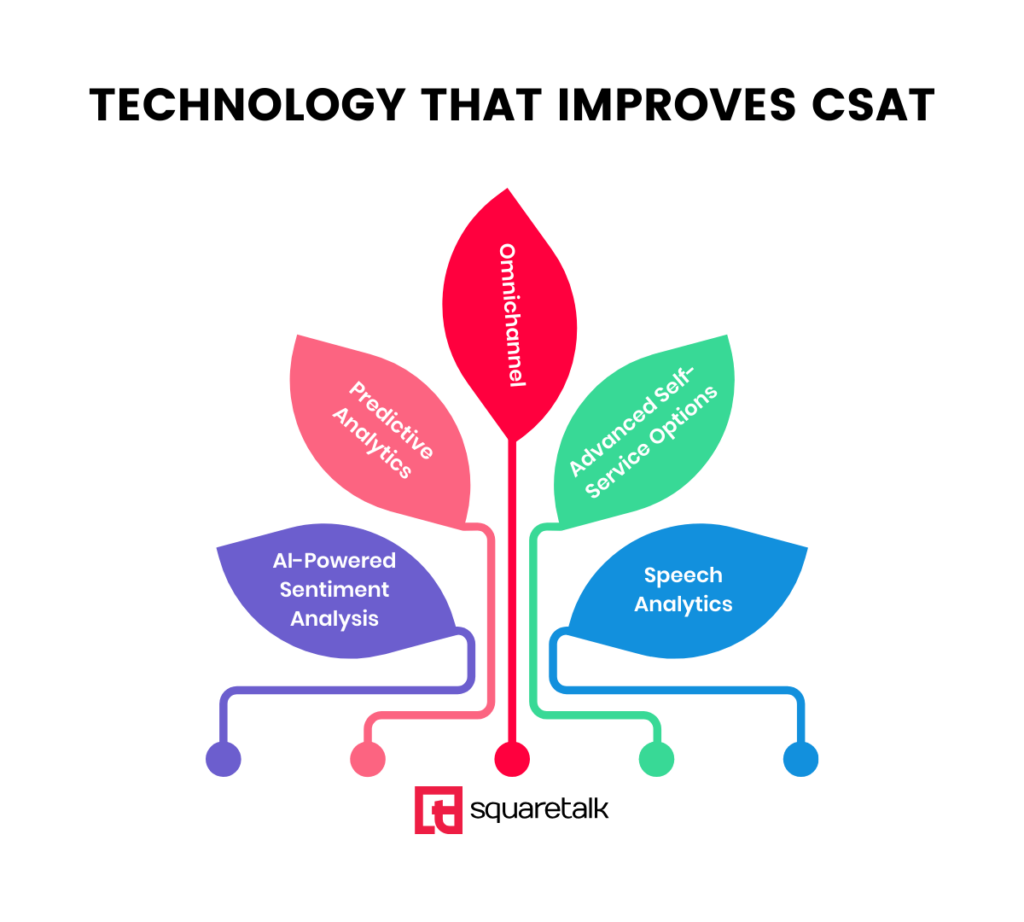
- 1. AI-Powered Sentiment Analysis: This technology analyzes customer voice patterns and language to recognize emotions in real-time. You can use these insights to tailor agent responses and improve the overall customer experience. Setting up alerts for negative sentiment detection can also allow supervisors to intervene at the right moment.
- 2. Predictive Analytics: By examining historical data from various touchpoints (calls, emails, chat, social media), these systems can forecast potential customer dissatisfaction. You can then use the data to identify patterns that lead to low CSAT scores and create proactive intervention strategies.
- 3. Omnichannel Integration: This technology offers a lot of benefits that directly impact CSAT scores. Omnichannel integration ensures a seamless customer experience across all communication touchpoints (phone, email, chat, social media), which builds trust and reliability. It’s also very convinient for customers, which they appreciate. Since all data is centralized, your agents have access to the full interaction history and can easily personalize the communication. The unified information also eliminating the need for clients to repeat themselves when switching channels.
- 4. Advanced Self-Service Options: AI-powered chatbots, an advanced IVR system and a user-friendly, searchable and comprehensive knowledge bases can handle many common queries and transactions. This will freeing up your agents for more complex issues and give customers a quick and easy way to solve simpler issues. To keep CSAT up, continuously update and improve these tools based on client interactions and feedback.
- 5. Speech Analytics: This technology transcribes and analyzes calls in real-time, flagging important keywords or phrases that might indicate a customer's satisfaction level. Integrating speech analytics software with your call recording system and defining key phrases and sentiment indicators to monitor will provide you with invaluable insights.You can use them for real-time agent assistance and broader trainings.
Final Words
In call centers, where every interaction can make or break a client relationship, CSAT is a vital tool for assessing and improving service quality. It directly measures how well your staff meets customer needs and expectations, especially in high-stakes situations.
This makes understanding and improving CSAT less of a numbers game and more of a process of creating meaningful and satisfying experiences for customers that drive loyalty and business growth.
As you implement effective measurement strategies, leverage advanced technology and follow best practices, remember that the journey to high CSAT scores is ongoing. A satisfied customer is not just a one-time win—it’s the foundation of sustainable business success.
FAQ
What is the Customer Satisfaction Score (CSAT), and how is it calculated?
A: Customers answer a single question—“How satisfied were you?”—on a 1-5 or 1-10 scale.
CSAT % = (Number of 4- or 5-ratings ÷ Total Responses) × 100.
Why is CSAT important for call centers and customer service teams?
A: It gives frontline managers near-real-time “voice of the customer” feedback that correlates with repeat purchase, churn and upsell potential.
What are the best practices for designing effective CSAT surveys?
- Trigger immediately after the interaction—memory fades fast.
- Keep it short (≤3 questions) to drive 25–40 % response rates.
- Use the same channel the customer just used (IVR after call, in-app pop-up, etc.).
- Offer optional word-for-wordcomment—rich insight for root-cause analysis.
- Tie survey goals to KPIs before launch to avoid vanity data.
How can businesses improve their CSAT scores?
- Close the loop—contact detractors within 24 h and log fixes.
- Empower agents with refund/credit authority to solve issues directly.
- Coach with call recordings + AI sentiment to uplift soft skills.
- Simplify effort—pair CSAT with Customer Effort Score to uncover friction.
What is considered a good CSAT score, and how does it vary across industries?
A: Benchmarks cluster between 65 % and 85 % overall. 2024-25 data shows online retail averaging 80 %, telecom 76 %, and SaaS 78 %. Best-in-class brands routinely top 90 %


